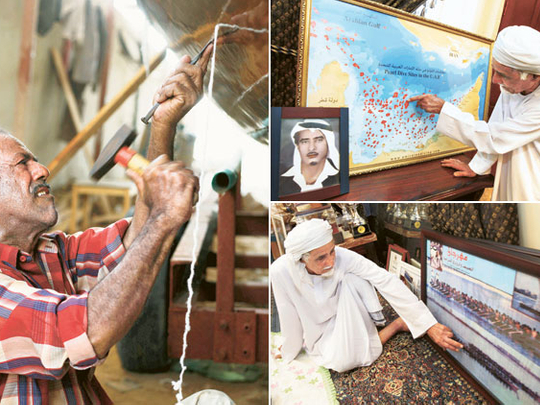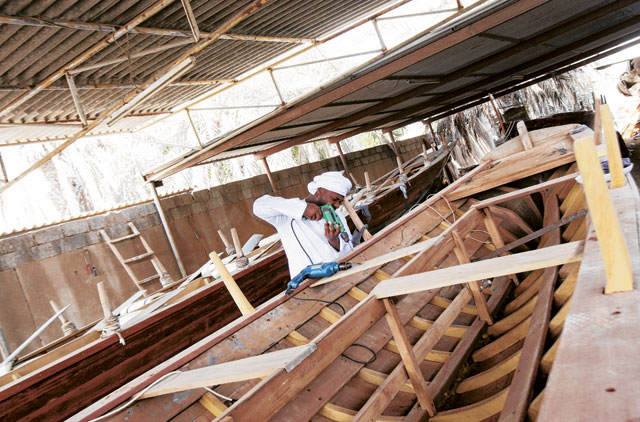
His hands are hardened, pitted on the palm. On their back, dark bruising appears where his blood vessels aren't as strong as they used to be. But then, after 80 years of living, savouring life, Ali Mattar Humaid Al Shamsi's body is bound to show a bit of wear and tear — just the slightest.
He is like an old boat — still sea-worthy but creaking in a few places. And if anyone knows a thing about boats, it is Al Shamsi.
He has been hand-building teak rowing skiffs for racing since he was 15. Hundreds of them.
Most are still cutting through the waves of the Arabian Gulf as swift and as keen as the day each of them hit the briny, shining water.
They are solid and strong, works of wooden art, each skiff now skilfully crafted in a dusty workshop built in Al Shamsi's garden in northern Ajman.
Al Shamsi is the last of his ilk, still building boats, still following the direction shown by the late Shaikh Zayed Bin Sultan Al Nahyan.
"The late Shaikh Zayed asked us to build these race boats all over the UAE, from Abu Dhabi down to Ras Al Khaimah," Al Shamsi says through a translator, his Khaleej-accented Arabic almost singing as he recalls with reverence the founder of the UAE. "He started the idea and made the suggestion," he continues. "That was more than 50 years ago."
As the UAE turns 40, Al Shamsi is quick to acknowledge the role played by Shaikh Zayed in bringing the different tribes and loyalties of the former British Trucial States together to found the United Arab Emirates on December 2, 1971.
Shaikh Zayed passed away and left behind a lot of goodness, he says.
"Before Shaikh Zayed, people used to travel for work, but he encouraged them to return and work here," Al Shamsi recalls, his deep brown eyes staring as if through the mists of time, remembering the rough times when life was hard and work was harder.
"Before Shaikh Zayed, the UAE was a barren place," he says.
Al Shamsi was born in the Al Hamriyah area of Sharjah and has never strayed far from there. His present home is on the north side of Ajman Creek.
"This place was empty and people did not dare approach for fear of ghosts and genies. Today, as you see, the streets are filled day and night," he says.
And that, he points out, is a direct result of the bringing together of the emirates by Shaikh Zayed.
In the background, a rhythmic thud of chisel on wood fills the workshop.
Under Al Shamsi's watchful eye, a worker feeds rope cord into the seams between two teak planks, packing it more tightly, neatly, with each strike of the hammer and the blunt chisel.
It is a rhythm of "tack-tack-tack, tack-tack-tack" so perfect that you could almost dance to it.
Beams of midday sun stream into the workshop, illuminating shafts of brown wood dust rising to the corrugated steel roofing which too is heating up under the sun's rays. Soon the morning's work will stop, only to be resumed in the cooler evening.
The wood dust forms a thick carpet on the workshop floor. Curled and frayed trimmings of shaved mahogany stick to clothes and shoes as they are carefully and near surgically removed from planks.
This is where the skills of generations is shown, each of the three crafts under varying states of construction treated with the same tenderness as a father would treat his children.
These skills are Al Shamsi's offspring.
Yes, he has a family, but no one has followed in his footsteps yet.
But this workshop is a place of creation, where wiry craftsmen slowly shape works of art, of nautical dreams and smoothed beams, where varnish and wood give life to sleek skiffs longing for the rush of water under their hulls.
Power drills and electric saws have replaced traditional tools. But that nod to progress has not allowed a compromise on quality.
Every nail and screw is still applied with the same care and attention as during the work of artisans decades ago.
Still wiry, still limber, Al Shamsi retrieves an old bow-and-rope-powered drill. He sits cross-legged under a hull and carefully, skilfully, drills a neat hole without missing a beat.
Not surprising — as he has been doing this for 65 years, just as his father taught him, and who in turn was taught by his father a generation ago.
The sea runs in Al Shamsi's veins — his heart is out on the ocean and his mind is full of memories of the life of coastal Arabs from Ras Al Khaimah to Kuwait and the marshes of Iraq. This is his Gulf, his life, his passion.
So much so that he has never driven a car.
Never?
"Never," he swears, because there was no need to. Once he knew how to sail and read the wind, sail the tides, ride the currents as they changed with the seasons and as the temperatures rose and the winds moved, there was no need to drive.
There are the Bedouins who know the ways of the desert, its dunes, its oases and its sabkah.
And there are the coastal Arabs, who know things nautical.
"My grandfather married a Bedouin woman, but I have always been a coastal Arab," he says with pride.
And it is that same pride that goes into the careful shaping of each rowing skiff, where money is but a means to an end, not the currency of those who know the currents as he does.
Out on the Arabian Gulf, the currency of life is the comradeship of those onboard, where loyalty is counted in the time spent together hauling nets, with hands on the tiller, descending the deep aquamarine waters and corals in search of pearls.
Yes, Al Shamsi was a pearl diver. Just as his father and grandfather.
Between June and October, the open waters of the Arabian Gulf were Al Shamsi's life, as he lived and dived as far as Kuwait, in the shallows off Bahrain and Qatar, out off the sweep curve of the Arabian Gulf off the Trucial States — long before the UAE was but a nascent dream.
"We have a saying in Arabic that means that the eyes of a person are his scales," Al Shamsi says. "I was 16 years old when I started pearl-diving. Sixty years ago, people used to leave the country to work in Saudi Arabia, Bahrain, Kuwait and other places. It was around the Second World War. Then we returned home and started making boats of different sizes. This is our work now."
According to Al Shamsi, he is the last of the old skiff builders in the UAE.
"They have all passed away," he says with a heavy heart. "They all have sons, but they did not pass the vocation on to them.
"However, there is one person, Shattaf. He still makes boats and his sons have treaded the same road. He works in Ajman."
Even so, Al Shamsi says, Shattaf's boats are not as good as his.
"I thank God that He has bestowed upon me a lot of goodness," he says.
And God has also bestowed on Al Shamsi four sons.
"One works for the government, one for the UAE frontier guards. The third works in Al Himriyah and my fourth son has a factory," he says proudly. "They live in different houses."
No one, however, is following in their father's footsteps — at least for now.
"They all know how to make boats, but they have not taken it up as a vocation," he says. "My elder son made a boat once which was better than the one I made for him."
The teak for each boat is imported from Africa in neat packaged bundles. Earlier, it used to be shipped in by dhow, traded for by the captains who plied the coastal waters as far south as Madagascar.
With good-quality teak costing about Dh300 per foot, a 40-foot boat costs Dh70,000. But it is not about sales, it is about passion and keeping the art of skiff-building afloat.
"People offer to give me Dh100,000 for a boat, but sometimes I do not sell," Al Shamsi says. "I do not care much for money. There is that in abundance from Allah."
Shaikh Zayed himself was a keen rowing-race enthusiast.
"In races he used to stand close to us when we stood in the water," Al Shamsi recalls. "Shaikh Zayed was Shaikh Zayed — he was one of a kind, a man of good nature and high ethics. He was the person who spoke to other countries; he convinced them and fought hunger. And he gave to everyone."
At his home, Al Shamsi proudly shows off his trophies of races won in Abu Dhabi, Dubai and Sharjah. And he is equally eager to show off an old pearl-diving map from 1991 which indicates the best places to dive.
"Here, in the Bakhoush area," he points out. "There is petrol there, and Sararah in Um Al Sheef, it is filled with petrol. And these were good places for pearls too. The divers work from the morning till noon. Diving in the afternoon is harmful."
Al Shamsi says that the biggest boat he has built can carry 137 rowers and that he raced it first in Abu Dhabi in 1991, pointing to a fading framed colour photograph of the race.
"This is Al Sharqi's Mutasadir, this is Al Nuaimis and this is the president's Al Habshi rocket," he says.
When it comes to pearling, Al Shamsi says the people of Bahrain, Qatar and the UAE were one and the same.
"I am from the UAE and I dived in Bahrain and Qatar and the same applied to them, as though we were one family," he says.
But it wasn't all good during the four months of pearling from June to October.
"There was thirst, and food was restricted on these trips," Al Shamsi says. But once back on the shore, "they were beautiful days, everything was in abundance. That was a good time — the neighbours were more helpful, the hearts of the people were together. One house would support ten houses when the need arose. If a visitor came to visit, ten houses would chip in for the hospitality."
During one trip at sea, Al Shamsi spent a night in the water. "I cried a little, I laughed a little and I sang a little, hoping that my boat would return," he said. "And I prayed a lot."
For Al Shamsi, family is all-important.
"How important?" I prod.
He disappears from the room and returns moments later with faded photocopies and scrolls in hands.
"I am the oldest living Al Shamsi," he says. "This is my family."
He rolls out the scrolls, which trace a family lineage going back almost three centuries. The charts are carefully kept, carefully updated, and passed on to new generations of the family.
Just like his skiffs plying the waters of the Arabian Gulf, the family keeps riding the waves and the tides of current events.













